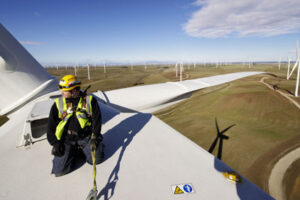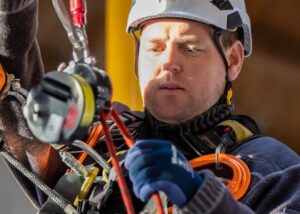As the global wind energy sector continues its rapid expansion, the demand for skilled professionals—including instructors who train and certify wind technicians—is also on the rise. Wind Safety and Technical Training Instructors are critical in preparing workers to safely and competently navigate the complex challenges of the wind industry, whether onshore or offshore.
This article outlines the full journey to becoming a certified Wind Safety or Technical Instructor, the required background and skills, certifications such as IQT and IQTX, and how STL USA offers the comprehensive support and resources necessary to succeed.
1. Background and Experience
To become a Wind Safety or Technical Training Instructor, a strong foundation in the wind energy industry is essential. Most instructors have:
Hands-on experience working as wind turbine technicians, often with major OEMs like GE, Siemens Gamesa (SGRE), or Vestas.
A working knowledge of GWO (Global Wind Organisation) standards and the environments in which wind turbines operate—often remote, at height, and under extreme conditions.
For technical instructors, experience in senior field roles is common—such as major component exchange, team leadership, or responsibility for mentoring new hires and supporting competency development.
Soft skills like communication, leadership, and coaching ability, which are essential across both safety and technical instructional roles.
Recommended Experience:
2–5 years in the wind energy or a related safety-critical industry.
Current or past involvement in technical or competency-based training—either internally at an OEM or with an independent service provider.
Prior completion of basic GWO training modules (e.g., Working at Heights, First Aid, Manual Handling, Fire Awareness).
For technical instructors: experience with GWO Basic Technical Training (BTT) modules is highly recommended.
2. Core Skills and Competencies
Beyond technical experience, aspiring instructors must demonstrate the ability to effectively teach, motivate, and assess trainees.
Essential skills include:
Instructional communication: Clarity in teaching complex safety or technical protocols.
Risk assessment and mitigation: Deep understanding of safety standards.
Assessment skills: Ability to evaluate participant competence.
Adaptability: Tailoring instruction to different learning styles.
For technical instructors specifically: an in-depth understanding of turbine systems, diagnostics, and repair processes is essential. The ability to break down complex mechanical or electrical concepts into teachable elements is key.
The ability to teach can be developed, but effective technical training relies heavily on the instructor’s own field knowledge and credibility.
3. Certifications Required: GWO IQT and IQTX
Instructor Qualification Training (IQT)
The IQT is the official GWO-approved training pathway to becoming an instructor for certified GWO training providers. This intensive course covers:
The GWO instructional methodology.
Safety-critical training delivery techniques.
Adult learning principles.
Assessing and recording learner performance.
Practical delivery assessments.
Instructor Qualification Training – Experienced (IQTX)
The IQTX is designed for experienced instructors looking to upgrade their credentials or add additional GWO modules to their instructional repertoire. It focuses on:
Evaluating and refreshing instructional best practices.
Updating knowledge to meet current GWO criteria.
Demonstrating instructional competence through performance-based evaluations.
IQT and IQTX apply to both safety and technical instructors. For those instructing GWO Basic Technical Training (BTT), a deep technical understanding and experience with turbine components is crucial to qualify for delivery.
4. The STL USA Advantage
STL USA is a leading provider of GWO-certified training in the United States, uniquely positioned to support professionals through every stage of the journey to becoming a Wind Safety Training Instructor.
Why Choose STL USA?
✅ All-In-One Training Resource
STL USA offers the full suite of GWO training modules, making it possible for aspiring instructors to:
Complete initial technician training.
Gain experience with standardized course content.
Seamlessly transition to instructor-level qualifications like IQT and IQTX.
Access both safety and technical training environments, including GWO BTT modules.
✅ Expert Trainers and Mentorship
With a team of highly qualified instructors and assessors, STL USA provides mentorship and coaching throughout the IQT/IQTX process, helping candidates refine their instructional skills and build confidence.
✅ State-of-the-Art Facilities
STL USA’s training centers are equipped with realistic, high-fidelity simulation environments, allowing instructors-in-training to practice their craft in conditions that mirror real-world wind sites.
This includes fully equipped training labs for mechanical, hydraulic, and electrical systems—essential for technical training delivery.
✅ Ongoing Professional Development
STL USA also offers continuing education and upskilling opportunities, ensuring instructors remain current with GWO updates, industry innovations, and emerging best practices.
5. The Roadmap to Becoming a Wind Safety Training Instructor
| Step | Milestone |
|---|---|
| Step 1 | Gain field experience in wind energy or a similar safety-critical role |
| Step 2 | Complete core GWO technician-level training modules |
| Step 3 | Identify a specialization: Safety Training or Technical Training (or both) |
| Step 4 | Enroll in the GWO Instructor Qualification Training (IQT or IQTX) at STL USA |
| Step 5 | Complete supervised instruction sessions under STL USA mentorship |
| Step 6 | Successfully pass practical teaching assessments and evaluations |
| Step 7 | Begin delivering GWO training modules as a certified instructor |
| Step 8 | Continue professional development with STL USA support |
6. Key Differences Between Safety and Technical Instructors
| Aspect | Safety Instructor | Technical Instructor |
|---|---|---|
| Background | General wind or safety-critical experience | Field leadership, OEM background, technical specialization |
| Focus Areas | Working at height, first aid, fire, manual handling | Mechanical, electrical, and hydraulic systems |
| Key GWO Modules | BST, ART | BTT, Slinger Signaller, Installation |
| Critical Skills | Risk management, emergency response, training delivery | Diagnostics, systems knowledge, technical problem-solving |
| Teaching Requirements | Strong classroom control and communication | Ability to simplify complex technical content |
Conclusion
Becoming a Wind Safety or Technical Training Instructor is a rewarding career path that combines technical knowledge with the ability to empower others. With increasing demand across the renewable energy sector, now is an ideal time to make the transition.
STL USA provides every tool, resource, and expert guide you’ll need to succeed—whether you’re taking your first step in the field or elevating your career through IQT or IQTX.
Ready to begin your instructor journey? Contact STL USA today and take the first step toward shaping the future of wind energy safety and technical excellence.
Ready to take the next step in your clean energy career?
Learn more about IQT and IQTX and becoming a wind safety or technical instructor by clicking the button.



